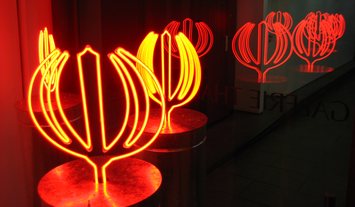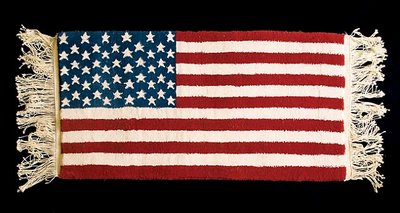Provocation with the Cult of Martyrdom

Mr Bakhshi-Moakhar, there's censorship in Iran. Can you still exhibit works which are critical of the government?
Mahmoud Bakhshi-Moakhar: One has to have permission from the ministry of culture before every exhibition. You get it by sending them a photo of the work – without a title. You don't usually have to provide any explanation. I've mostly not had any problems. Only once was an exhibition of mine closed.
Why?
Bakhshi-Moakhar: The exhibition was held in a Tehran cultural centre. I showed my installation "Air Pollution of Iran". It's made up of eight framed Iranian national flags, and the eight refers to the eight years of the Iran-Iraq War. I bought the flags in a shop in Tehran. They were old and dirty. The white and green stripes had gone grey and exhaust fumes had got deep into the material.
The air pollution in Tehran is very serious. But the viewer understands that your installation is also about something more than just exhaust fumes. One also thinks about the poisoned atmosphere in the country …
Bakhshi-Moakhar: I don't like to explain my works.
I've read that you hung the flags out on the roof of a tall building from which one can see the Evin prison, where many members of the political opposition are held.
Bakhshi-Moakhar: I've read that too, but it's not true.

You have pictures hanging in your apartment in Tehran in which the Iranian flag has been cut in pieces and sewn together with bits of traditional folk material. The symbol of the nation has been destroyed. Would you be able to show this work to the ministry of culture?
Bakhshi-Moakhar: I didn't try to do so in that case. All the same, artists in Iran are relatively free. If the government were to arrest one of us, it would only bring us more attention. People would be curious and ask what these artists are doing. The contemporary art scene in Tehran is relatively small. Nobody cares much what we show in the galleries – neither the government nor the public.
You recently took part in a group exhibition in Tehran. The visitor to the exhibition came in to a dark room in which flowers made of neon lights were growing. What was this work about?
Bakhshi-Moakhar: The flowers are stylised tulips. They're equipped with a mechanism with which viewers can get them to turn. You find the tulip in the centre of the Iranian flag. It's a simplified form of the Arabic word for Allah and also a symbol for the martyrs.
There's a belief in Persian mythology that a tulip grows wherever the blood of a fighter is shed for his country. My installation is called "Tulips Rise from the Blood of the Nation's Youth." The title refers to a famous poem dedicated to the martyrs of history.
Following the presidential election in which [the incumbent] Ahmadinejad was accused of fraud, many people went on to the streets in support of [his challenger] Mussavi. Some were killed. They died as martyrs. I covered the walls of the gallery with black cloth, just as one does at a funeral. Most martyrs die anonymously and without a funeral, and I wanted to draw that to people's attention.
The Islamic Republic has its own cult of the martyr. But your works have nothing to do with that...
Bakhshi-Moakhar: The walls of the buildings in Tehran have paintings of martyrs, bearded warriors, larger than life-size, who stand in a field of tulips. They look like advertisements and for that reason they are interesting for tourists or some artists. But I grew up with pictures of real war.
I was two years old when Khomeini came back to Iran from exile and proclaimed the Islamic Republic. I was three years old when the Iran-Iraq war began. I've grown up with families who lost their fathers. What is magnificent about that?
Do Iranians immediately understand the critical aspect of your work?
Bakhshi-Moakhar: Yes.

How did you come up with the idea of using the Iranian national emblem in your tulip sculptures?
Bakhshi-Moakhar: Such sculptures are not unusual in Iran. You find them on public squares in every big city. I reproduce the symbol in various materials. The flowers can be seen as a continuation of my work with flags and air pollution. The flags too have to do with the martyrs. It's all about those who have died in the war, or the people who die of air pollution in Iran.
For another work you used the American flag as a doormat...
Bakhshi-Moakhar: In the Islamic Republic there are American flags painted on the floor in front of many ministry or other public buildings. If you want to get into the building, you have to trample on the American flag. It's a humiliation which one is forced to carry out. In effect I was making a joke about it. My doormat looks like Persian craftwork and could be manufactured by the government in industrial quantities.
You travel a lot for your exhibitions. You've exhibited in Switzerland, Germany, France and England. Do you find that you get any inspiration from Western art?
Bakhshi-Moakhar: I love minimalist art. But Iranian poetry and Sufism, the Islamic mysticism, influence me more than any Western artist.
Before the presidential election, 800 Iranian artists signed up in support of Mussavi as candidate. Did you vote for Mussavi too?
Bakhshi-Moakhar: Yes, of course. Everyone voted for him. He's a reformer like ex-president Khatami. Ever since Ahmadinejad became president, we've had to show our works to the ministry of culture before we can exhibit them. Our artistic freedom has been increasingly restricted.
Do you believe that you will choose topic in the future which have less to do with Iran?
Bakhshi-Moakhar: It's not easy to make art which has nothing to do with the current situation in Iran. The situation is tense. And that gives me plenty of ideas for my work.
Interview: Carola Hoffmeister
© Qantara.de 2009
Mahmoud Bakhshi-Moakhar, was born in 1977 and lives and works in Tehran. He studied graphic art and visual arts at Tehran University, specialising in sculpture. He has become internationally well-known as a result of a number of group exhibitions, and has exhibited in Berlin, Paris, London, Athens and Beijing. The "Magic of Persia Contemporary Art Prize Finalists' Exhibition" in London is showing his works from 15th to 17th October.
Translated from the German by Michael Lawton
Qantara.de
Artistic Freedom and Cultural Policy in Iran
Art under Divine Dictatorship
Iran's artists made good use of the brief period of opening under the liberal President Khatami. However, the Islamic Republic's increasingly rigid cultural policy is now threatening to wipe out all they achieved at the time. By Alessandro Topa and Roshanak Zangeneh
Parastou Forouhar
Art as a Political Weapon
The Iranian artist Parastou Forouhar's parents were murdered eleven years ago. She has been fighting ever since, for a conviction of their killers and against the system in Iran – including through her art. Werner Bloch on a courageous artist
New Exhibition of Contemporary Art in Teheran
Unusual Images for the Islamic Republic
For years they wasted away in the basement of the Teheran Museum for Contemporary Art. The paintings of well-known artists of the twentieth century had long ago been deemed "Western works of the devil" by the Mullahs. Now they have been recovered from their hiding place and put on display at the museum. Martin Ebbing reports from Teheran
www
Mahmoud Bakhshi-Moakhar's website (in English)